Approximately eighty percent of our immune cells are located in the gut. Many of us have less-than-robust probiotic or ‘good bacteria’ in our intestines due to many factors such as overexposure to antibiotics, high-consumption of sugar, refined flour, and processed foods, overuse of anti-bacterial soaps, etc.
Gut Flora is now being referred to as a separate “organ” of the body. Why are gut flora important? Research is beginning to show that “good” bacteria play dozens, if not hundreds, of roles in maintaining our health. Here are five:
-Bacteria in our intestinal tracts produce B vitamins and vitamin K. These vitamins play important roles in energy metabolism (producing energy from food), maintaining the health of the nervous system, and clotting blood.
-Bacteria in the large intestine digest fiber and use it to produce chemicals that feed and protect the intestinal lining. This lining plays key roles in preventing infection, boosting immunity, and reducing inflammation. If the lining breaks down, chemicals that should never leave the intestines end up in the bloodstream, which can lead to inflammation or an overactive immune response.
-Gut floral produce most of the body’s serotonin, a key neurotransmitter. Scientists are beginning to see connections between the health of the gut and the health and functioning of the brain.
-Intestinal bacteria produce enzymes that metabolize drugs, hormones and toxins. In addition, they produce chemicals that “communicate” with the liver regarding production of enzymes used in detoxification.
-Gut bacteria may play a role in obesity. Some animal studies, and now a few human studies, have shown that animals or humans deficient in certain bacteria may be more prone to gain weight.
You can change their gut flora in ways that will benefit your health. Here are five things we can do:
-Eat foods that include natural probiotics (good bacteria). These include yogurt and fermented foods, such as kefir and sauerkraut.
-Eat fewer processed foods. Processed foods lack many of the nutrients that contribute to a healthy “climate” in the intestines. In addition, they tend not to contain the kinds of healthy bacteria found in more natural forms of food. (For example, think of a processed cheese product vs. real cheese. The former doesn’t contain any bacteria when it leaves the factory, but the latter contains plenty of “good” bacteria – and it tastes delicious!)
-Eat foods high in fiber, such as fruits, vegetables and whole grains. Plant fiber feeds the bacteria in the large intestine, and they in turn produce chemicals that protect the intestinal lining. (Another drawback of a diet heavy in processed foods is that it’s generally low in fiber.)
-Take antibiotics only when necessary. If your doctor says, “Let’s wait a day or two to see if you need antibiotics,” don’t insist on getting some right away! Antibiotics can significantly alter the gut flora, killing off beneficial bacteria and providing an “opening” for harmful bacteria to move in and “set up shop.” When you do take antibiotics, take steps during and after treatment to re-establish a healthy gut microbiata.
-Consider taking probiotic supplements
-Eat Fermented foods. Traditionally fermented foods are found in different cultures throughout the world. These foods include sauerkraut (fermented cabbage) and other fermented vegetables, kimichi, tempeh, natto, kombucha, and fermented raw dairy such as yogurt, and kefir.






 You have all asked is there fibre in our raw juice? Yes. The separation you see in picture that 80 percent is the fiber. And this juice is apple, cucumber, parsley, cilantro, kale, lemon.
You have all asked is there fibre in our raw juice? Yes. The separation you see in picture that 80 percent is the fiber. And this juice is apple, cucumber, parsley, cilantro, kale, lemon.